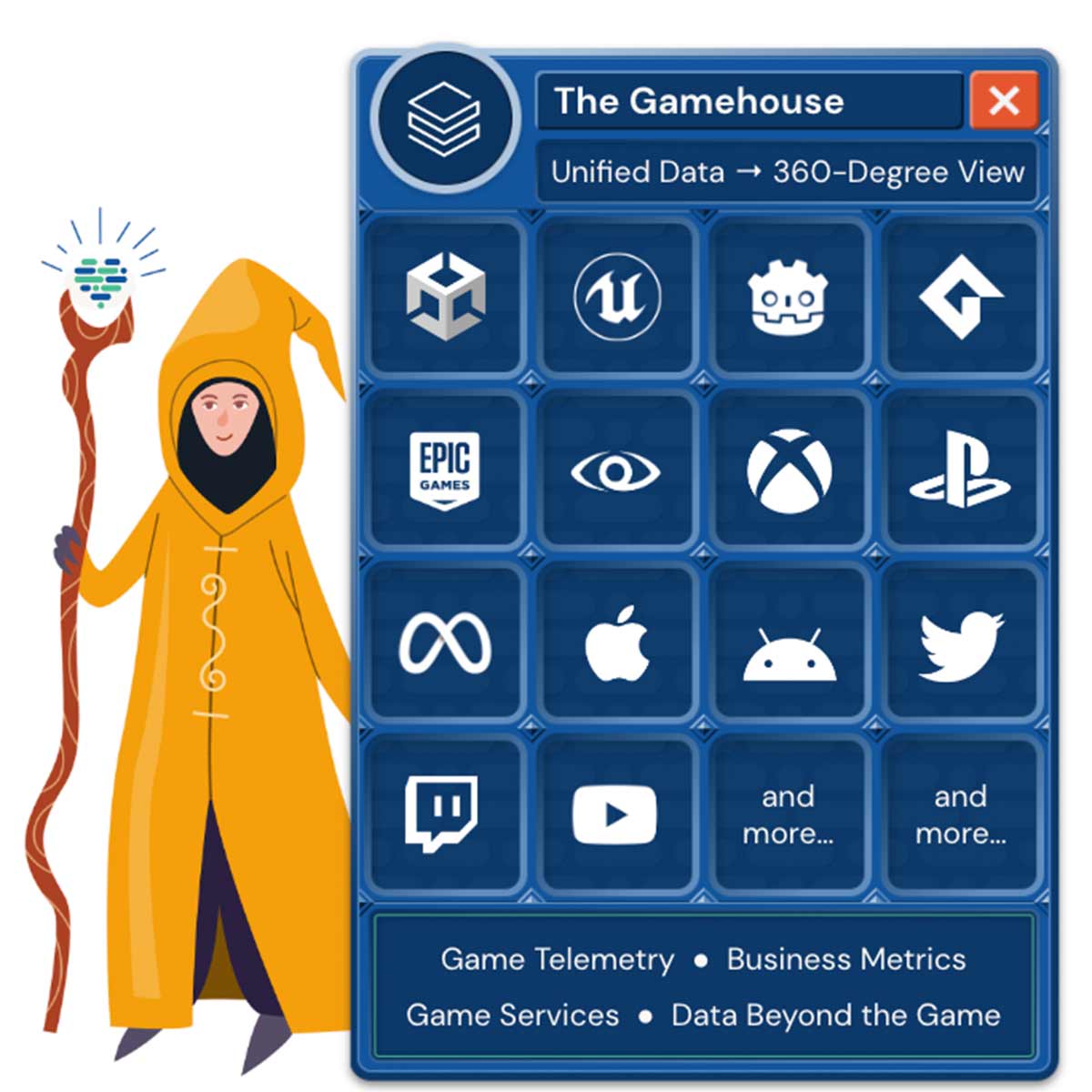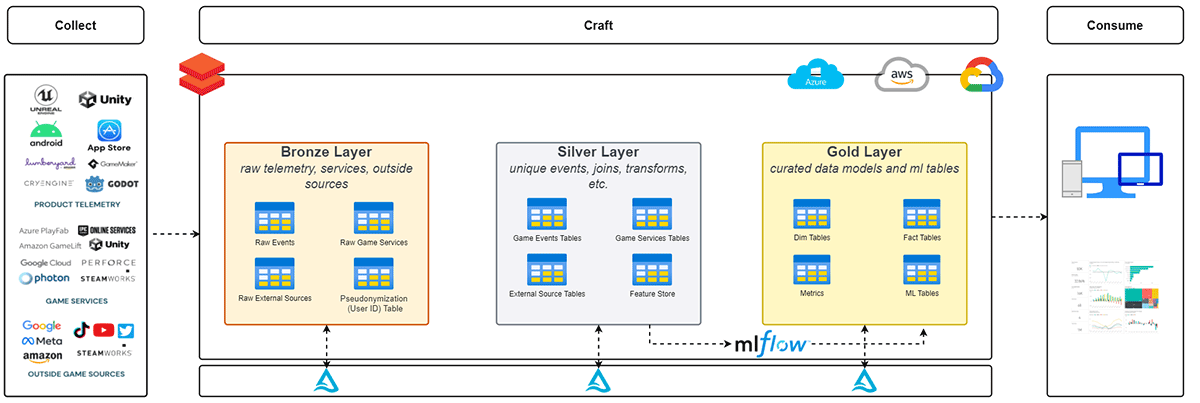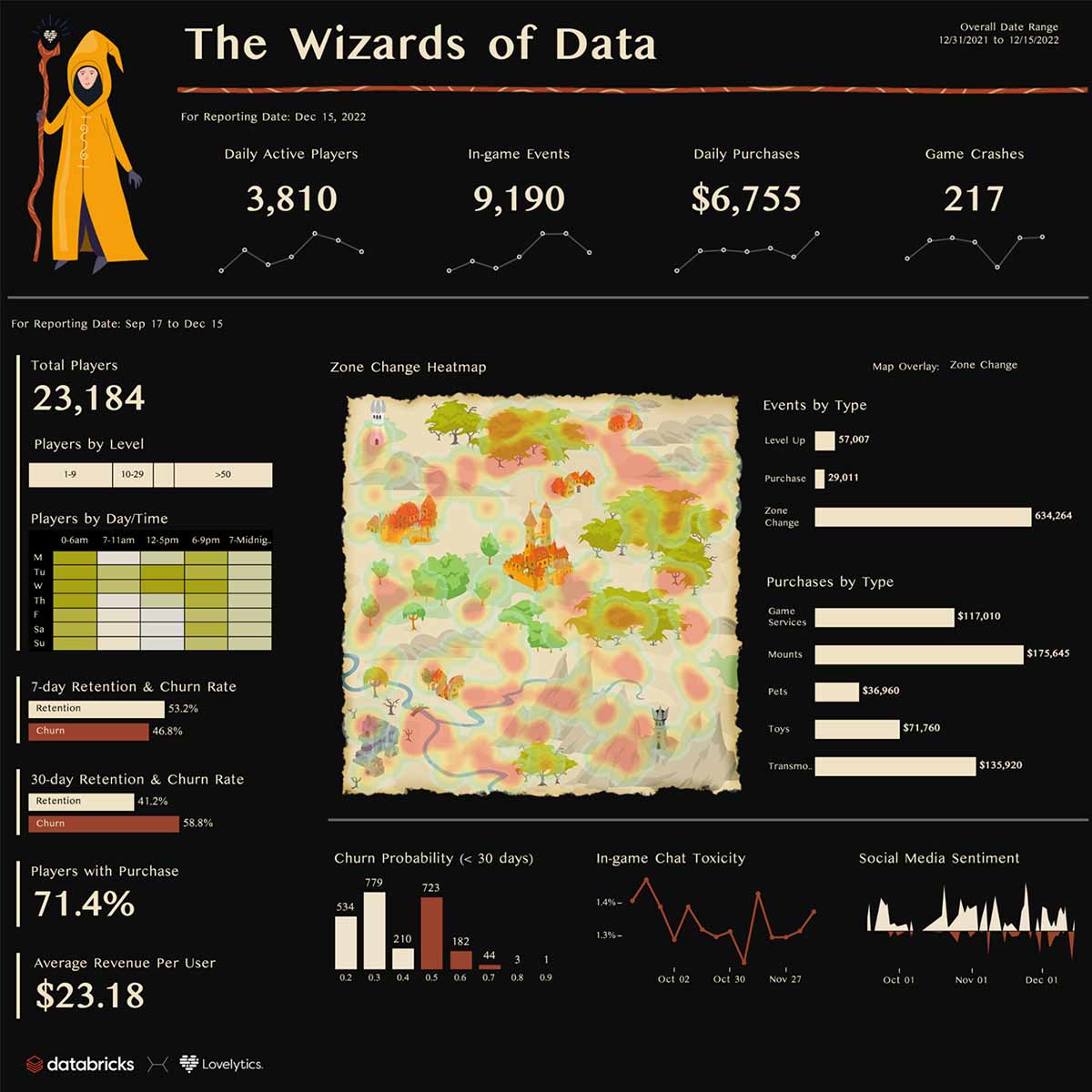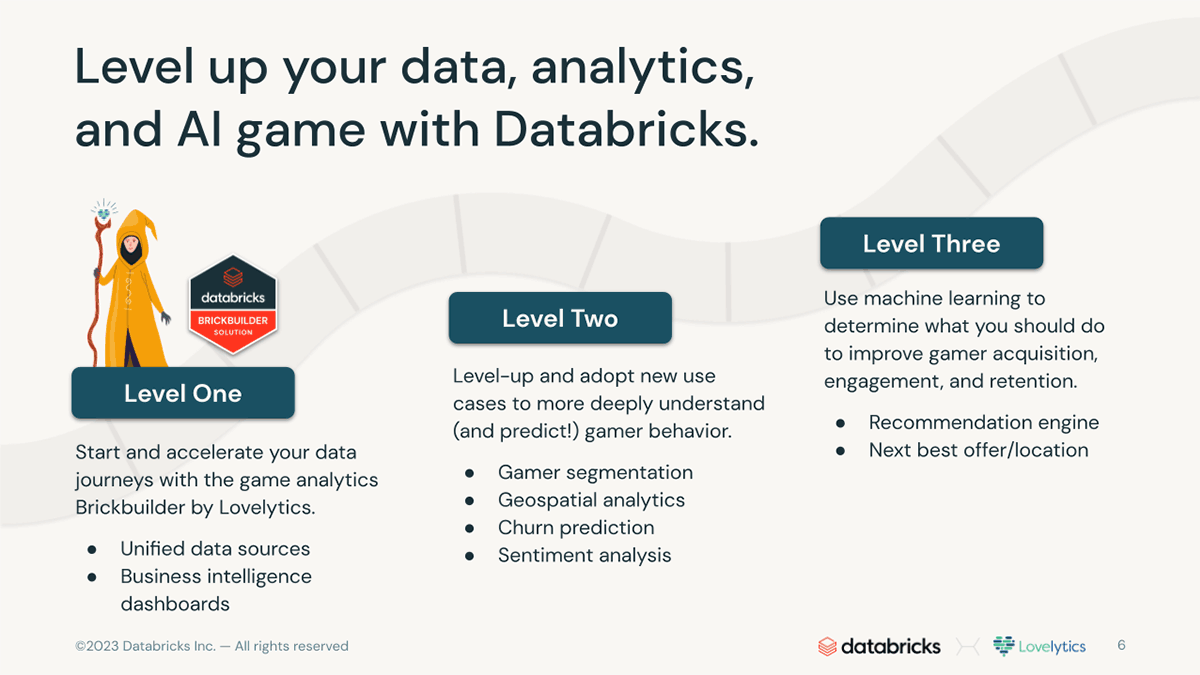Introducing Gamehouse: A Lovelytics Game Analytics Brickbuilder Solution
Quickly stand up a 360-degree view of your game using Lovelytics’ game analytics Brickbuilder Solution

We're thrilled to announce the launch of Gamehouse - a new Brickbuilder solution. This modern reference architecture for game analytics is the result of a partnership between Databricks and Lovelytics, and was designed to help game studios of all sizes level up their data and AI strategies. Gamehouse gives studios a best-practice framework for unifying ALL of their game and community data, creating a 360-degree view of their business that unlocks actionable insights for gamer acquisition, engagement, and retention.
For most game studios, the first step on their data and AI journey is setting up game analytics. Unfortunately, that's easier said than done. Games generate immense amounts of data from multiple sources, including game telemetry and backend services. Add in marketplace and platform data, along with information from sources outside the game, such as social media, and it's easy to see how analytics become complex, quickly.
The amount of data, and the speed at which it's generated, are only increasing. That leaves many game teams overwhelmed, and forced to operate within data silos. Data from various sources are fed into disconnected systems—think content management systems (CMS), customer data platforms (CDP), and others—each of which was purpose-built for a specific use case, and walled off from every other system. As a result, data is trapped, preventing teams from maximizing its potential. Data use cases that rely on or benefit from connected data, such as in-game personalization, become less productive, less efficient, and less effective. Innovation grinds to a halt.
Costs can quickly escalate when the data stack supporting the broader tech footprint forces the presence of data silos, where data is copied and stored in multiple places. We've reached a tipping point, where maintaining the status quo is simply too complex and expensive. (And remember, we're only talking about setting up game analytics!) For teams that want to segment their community by persona, run predictive churn models, or build automated next-best-action sequences, the unification of data is no longer 'nice to have,' it's essential.
Quickly unify data from popular sources
Data is your studio's most powerful asset. But to leverage it effectively, three things need to be true; 1) It needs to be unified, 2) the right people need to be able to access it at the right moment, and 3) you need to be able to ask questions and get answers in real-time as the business scales. This is where many teams get stuck.

Let's look at the different types of data sources game teams have to work with:
- Game Telemetry. Game telemetry is the data collected about player behavior and interactions within a game. The primary source tends to be the game engine, such as Unity, Unreal, Godot, GameMaker, CryEngine, or Amazing Lumberyard. Key metrics include concurrent player count, player progression, engagement, in-game purchases, and game performance, among others.
- Business KPIs. Business KPIs (key performance indicators) measure the performance and success of a video game against its strategic and operational goals. Data sources vary, but could include the game engines referenced above, as well as stores and marketplaces (e.g., Xbox, Playstation, Meta, Apple, Android, etc.). Critical metrics include revenue growth, average revenue per user, gamer acquisition cost, gamer retention rate, and more.
- Game Services. Game services provide critical infrastructure that requires careful monitoring and management. These services include game server hosting, multiplayer networking, matchmaking, player voice and chat, and more. Here, the sources of data are the game services used, such as Epic Online Services, Steamworks, Photon, Perforce, Microsoft Azure Playfab, and Unity Operate. Key metrics include server uptime, latency and response time, server player count, error rates, and security incidents.
- Data Beyond the Game. Finally, we have data sources that live beyond the video game. These can include social media data, forum data, and player reviews. Data sources will vary widely, but typically include social media sites like Reddit, Twitter, TikTok, and Facebook, video sites such as Twitch and YouTube, and player review sites like Steamworks and Epic Games Store.
Suffice to say, that's a lot of data. How do you know what's most important? Do you need all these sources? Or just some? And once you have the data—maybe you're accessing directly at the source—how do you bring it all together? Read on.
Game telemetry, game services, and the myriad of other available external-source data can be varied and complex to integrate. Fortunately, the Gamehouse reference architecture considers all the different methods for collecting that data, such as streaming, batch, and API. Gamehouse is designed to work with any cloud, including Azure, AWS, and GCP. So your team can make deployment even easier. Here's how it works:
- Following the medallion architecture, once all source data has been collected into the bronze zone, it's time to blow out those events into unique events tables, and perform any cleaning, validations, joins, and transformations necessary to prepare your data for ML and BI requirements within the silver layer.
- Features can be created in the feature store and made available offline and online for your desired use. The semantic layer for visualization and reporting needs can be created within the gold layer.
- ML models are trained and made available through MLflow to support your unique serving needs, whether those are on-demand, streaming, or batch.
- The data products can then be utilized by your applications, reports, and many other consumption layer needs.

Uncover comprehensive, actionable insights
Once your data is unified, stakeholders across the team will have access to a real-time, 360-degree view of what's happening in and around your game. Imagine what you could do with comprehensive insights. You might take targeted action to acquire new gamers more efficiently, leverage gamer feedback to improve the in-game experience, mitigate disruptive behavior to deepen relationships with your playerbase, and so much more. Here are a few examples of what a team can do with this Game Analytics dashboard:
- Acquire new gamers more efficiently. A game analytics dashboard can provide valuable insights into the effectiveness of marketing campaigns and player acquisition strategies. By tracking metrics such as cost per acquisition, conversion rates, and user retention, a studio can identify which campaigns are most successful and adjust their marketing strategy accordingly. For example, if your studio notices that gamers acquired through social media campaigns have a higher retention rate than those acquired through paid advertising, you may consider shifting your marketing budget toward social media to acquire new gamers more efficiently.
- Improving the gamer experience. An analytics dashboard can also help studios improve the gamer experience by monitoring community feedback and in-game statistics. By tracking metrics such as win rate, item usage, and character performance, you can proactively identify imbalances in the game and make adjustments to ensure that gameplay is fair and enjoyable for all gamers. For example, if you notice that a particular character is being used in a majority of matches and has a significantly higher win rate than other characters, you may consider adjusting the character's abilities or introducing a countermeasure to level the playing field and encourage more diversity in character and or item choice.
- Track revenue and spending patterns in the game. If your dashboard indicates a drop in revenue, you can investigate whether it's due to a pricing issue, or if players are experiencing technical difficulties with purchasing items. Proactively addressing these issues can prevent a widespread loss of revenue and maintain the game's popularity among your community.
Here is an example of the Gamehouse architecture in action. We have used this architecture to stand up a Tableau dashboard using a data set from World of Warcraft. Here, we've selected a set of core metrics that a fictional data team may want to review on a consistent basis. Metrics can easily be subbed out, depending on priority, or additional dashboards can be created for specific use cases. We encourage you to play with the filters, such as data range, map overlay, and more.

Start your data and AI journey on the right foot
We can all appreciate the transformational power of AI and machine learning (ML). But most studios aren't ready to adopt more advanced analytics use cases, such as recommendations, churn modeling, and multi-touch attribution, because their data lives in silos. In order to effectively build toward more advanced data and AI use cases, your data strategy must FIRST leverage an architecture that enables it. That's where Gamehouse, Lovelytics' game analytics solution, comes in.
Simply by deploying Gamehouse, you're doing the hard work of getting your game data into a Lakehouse architecture that unlocks more advanced data and AI use cases.

Start your journey today
To get started, head to the Lovelytics website and hit Connect With Us. Whether you want to stand up the dashboard yourself, or are looking for help, Lovelytics has the technical expertise to get you there.
About Lovelytics
Lovelytics is a services firm that delivers data, analytics, and outcomes that people love. As a Databricks partner—a recipient of the 2022 Innovation Partner of the Year Award—Lovelytics specializes in implementations and data, analytics, and AI solution development. With expertise in game analytics, Lovelytics has partnered with several independent, AAA, and AA studios to unlock all of their game and player data and improve player acquisition, engagement, and retention.
Never miss a Databricks post
What's next?

Product
November 27, 2024/6 min read
How automated workflows are revolutionizing the manufacturing industry

Media & Entertainment
December 10, 2024/9 min read
